Gallim Dance at BAM Fisher, May 21-26, 2013
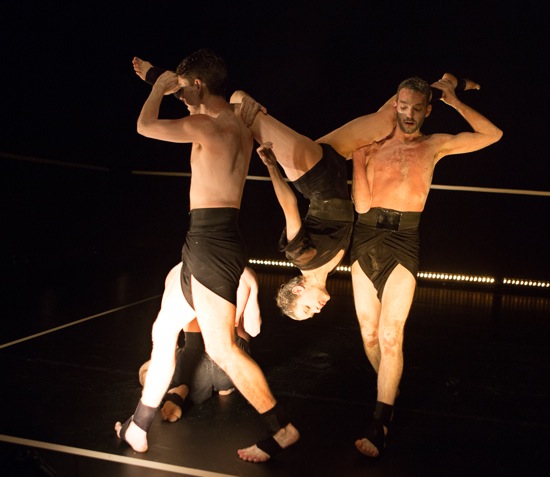
Jonathan Royse Windham (L) and Dan Walczak upend Francesca Romo in Andrea Miller’s Blush, Austin Tyson (hidden) on floor behind them. Photo: Yi-Chun Wu
What does “blush” convey to you? A person becomingly embarrassed? A person ashamed? The reddening sky of dawn? If it were not for the association of “flush” with toilets and wealth, I’d consider it an apter title than Blush for Andrea Miller’s revised 2009 dance. The six go-for-broke members of her Gallim Dance do indeed turn red in the face over the course of this powerful work, but the cause is their exertions. Vincent Vigilante’s lighting design often turns the BAM Fisher’s black-box stage dark and shot through with spectral beams, but even so, you can see the spotty white makeup on the dancers’ hair, faces, and bodies gradually running with sweat, leaving increasingly large pink patches of hot skin.
Miller has accomplished a great deal since she founded her company in 2007—not only choreographing for Gallim but for other professional companies and for student ones. She is, I think, in love with effort and with the complex ways the human body can sense changes in the atmosphere—both exterior and interior—and respond to them. She has admitted to being a fan of wrestling, although I can’t say whether she meant that she only watches matches or that she also engages in them.
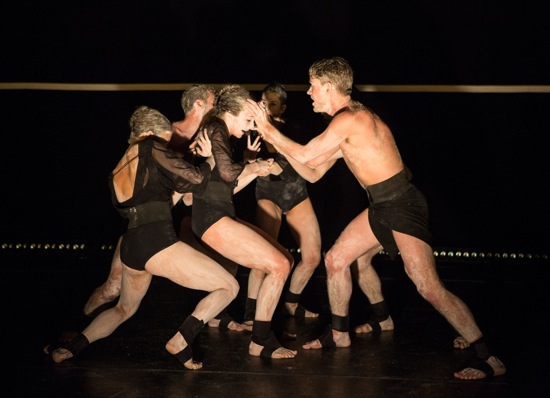
Gallim Dance in Blush. L to R: Caroline Fermin, Dan Walczak (partly hidden), Troy Ogilvie, Francesca Romo, Jonathan Royse Windham, Austin Tyson (only on leg visible). Photo: Yi-Chun Wu
In the late 1920s, when Martha Graham was working her way into modernism, she wrote that “Ugliness may be actually beautiful if it cries out with the voice of power.” Even now, when “ugliness” has been redefined in many ways and banished in others, quite a few people might have trouble accepting that statement. Not Miller. When Blush begins, you can hardly make out the figure in the center of the stage; the only illumination is a row of lights at floor level on either side of the performing area. He (it turns out to be Dan Walczak) knots his body and limbs as if he’s accommodating to a small space, scrabbles along, walks in a squat, whirls into turns, and collapses. When he manages to rise and balance on one leg, that leg is turned in, and he’s wavering as the lights go out.
When the stage brightens, a drumbeat kicks in under a high throbbing, and water sounds emerge, three women (Caroline Fermin, Troy Ogilvie, and Francisca Romo) dance in unison. Fermin and Ogilvie have known Miller since her Juilliard days, and Romo co-founded Gallim and is now its associate director); they’re her kind of anti-heroic amazons. They can jump as if launched by catapults, but they tend to stay low to the ground—feet planted wide apart, knees bent, bodies hunkering down. Turning, stepping out, reaching with widespread and weighted arms. . . . If the floor were a field, they’d have it ploughed and planted by now.
Meanwhile Austin Tyson, Jonathan Royse Windham, and Walczak lie on their sides at the rear of the area. Inching along, their bare torsos pale, they look like larva fighting their way to the next stage of life.
The floor is edged with white tape to suggest a sports arena, and another white tape runs along the side and back walls at chest height. A string of amber lights, bordering the floor against the black wall, comes on at certain times; at another point, circular pools of white light appear. Jose Solis’s costumes allude vaguely both to fashion and to Greek games. The women wear black trunks and rather glamorous, almost backless, full-sleeved blouses. The men wear short, belted, black drapes over matching diaper-type underpinnings. All the performers’ ankles and arches are bound with fabric that suggests sandals.
Like the twelve performers in Miller’s 2010 Wonderland, these people make up a tribe. But Wonderland—influenced by the life-like wolf packs of Cai Guo-Qiang’s Guggenheim installation, Head On—suggested herd and mob behavior with a wildness both amusing and terrifying. In the smaller society of Blush, conformity—when it occurs—is a given, and power struggles erupt and die away like tests accomplished. Sometimes the dancers project the image of a primal group that could be struggling its way to a more evolved state. In the last section, to Wolf Parade’s “I’ll Believe in Anything,” they run and leap around the stage in a loose, playful gang—grinning and sometimes singing along with the vocalist. But at the very end, they follow Ogilvie’s lead, backing away into a corner and staring across the long diagonal.
I’m impressed by the way Miller blends ferocity with disciplined form, whether in three brief contrapuntal duets or during a sequence in which everyone behaves individually at the same time. When several people hold out their hands, palms up, and alternate them in up-and-down motion—as if estimating the comparative weight of two objects—they’re not in immaculate unison, but consensus is obvious.
Given the fierce energy of the movement, Miller’s choice of music is so surprising that you can’t imagine it working, but it does. “Ballybane” by Manyfingers is followed by Andrzej Przybytkowski’s original composition “Birds,” a Chopin prelude, “New Breath” by Kap Bambino, Arvo Pärt’s familiar “Fratres,” and the Wolf Parade song.
Among the dauntless, determined athletes in who-knows-what arena, push and pull are primary dynamics, never more ingeniously explored than in a fairly extended duet for Tyson and Walczak. Punishing and intricately designed, it conveys neither animosity nor fight-to-the-death competition, even though Tyson covers Walczak’s eyes at one point as they rush along. Suddenly Walczak leaves, and Tyson runs in circles alone. He ends up stopped at a corner, looking around for his antagonist.
On some level, Blush is unfathomable. On another it’s as dangerously, sensuously present as a touch on your own flesh.

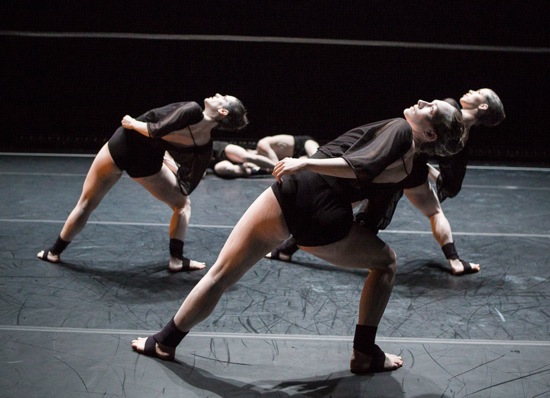
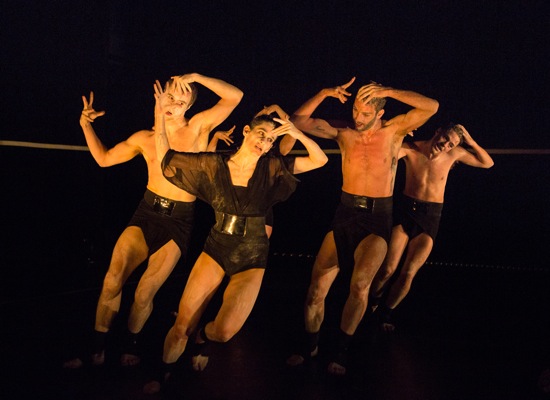
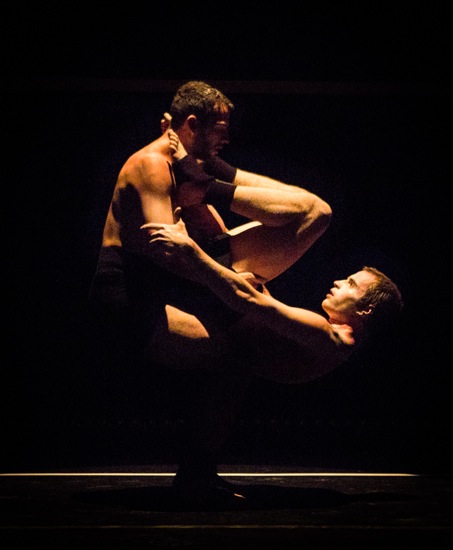
I’m not sure if it’s your comment about wrestling at the top of the review, but the orange and black tones in some of the photos made me think of Greek vase paintings — all those young athletes.